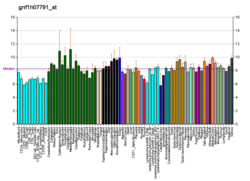CD109
gene da espécie Homo sapiens
CD109 (Grupo de Diferenciação 109) é um gene humano.[2] CD109 é um antígeno de superfície celular ligado a GPI expresso por linhagens celulares[3][4][5] de leucemia mieloide CD34 +, linhagens de células T, linfoblastos T ativados, células endoteliais e plaquetas ativadas.[6]
Referências
- ↑ «Human PubMed Reference:»
- ↑ https://www.ebi.ac.uk/ipd/hpa/table1.html
- ↑ Kaur, G; Dufour, J. M (2012). «Cell lines». Spermatogenesis. 2 (1): 1–5. PMC 3341241 . PMID 22553484. doi:10.4161/spmg.19885
- ↑ Jill Neimark (27 de fevereiro de 2015). «Line of attack». Science. 347 (6225): 938–940. doi:10.1126/science.347.6225.938
- ↑ Henle W, Henle G (1980). «Epidemiologic aspects of Epstein–Barr virus (EBV)-associated diseases». Annals of the New York Academy of Sciences. 354: 326–31. PMID 6261650. doi:10.1111/j.1749-6632.1980.tb27975.x
- ↑ «Entrez Gene: CD109 CD109 molecule»
Leitura adicional
editar- Lucas GF, Metcalfe P (2000). «Platelet and granulocyte glycoprotein polymorphisms.». Transfusion medicine (Oxford, England). 10 (3): 157–74. PMID 10972910. doi:10.1046/j.1365-3148.2000.00250.x
- Sutherland DR, Yeo E, Ryan A, et al. (1991). «Identification of a cell-surface antigen associated with activated T lymphoblasts and activated platelets.». Blood. 77 (1): 84–93. PMID 1984805
- Kelton JG, Smith JW, Horsewood P, et al. (1990). «Gova/b alloantigen system on human platelets.». Blood. 75 (11): 2172–6. PMID 2346781
- Lin M, Sutherland DR, Horsfall W, et al. (2002). «Cell surface antigen CD109 is a novel member of the alpha(2) macroglobulin/C3, C4, C5 family of thioester-containing proteins.». Blood. 99 (5): 1683–91. PMID 11861284. doi:10.1182/blood.V99.5.1683
- Schuh AC, Watkins NA, Nguyen Q, et al. (2002). «A tyrosine703serine polymorphism of CD109 defines the Gov platelet alloantigens.». Blood. 99 (5): 1692–8. PMID 11861285. doi:10.1182/blood.V99.5.1692
- Giesert C, Marxer A, Sutherland DR, et al. (2003). «Antibody W7C5 defines a CD109 epitope expressed on CD34+ and CD34- hematopoietic and mesenchymal stem cell subsets.». Ann. N. Y. Acad. Sci. 996: 227–30. PMID 12799300. doi:10.1111/j.1749-6632.2003.tb03250.x
- Mungall AJ, Palmer SA, Sims SK, et al. (2003). «The DNA sequence and analysis of human chromosome 6.». Nature. 425 (6960): 805–11. PMID 14574404. doi:10.1038/nature02055
- Ota T, Suzuki Y, Nishikawa T, et al. (2004). «Complete sequencing and characterization of 21,243 full-length human cDNAs.». Nat. Genet. 36 (1): 40–5. PMID 14702039. doi:10.1038/ng1285
- Solomon KR, Sharma P, Chan M, et al. (2004). «CD109 represents a novel branch of the alpha2-macroglobulin/complement gene family.». Gene. 327 (2): 171–83. PMID 14980714. doi:10.1016/j.gene.2003.11.025
- Zhang JM, Hashimoto M, Kawai K, et al. (2005). «CD109 expression in squamous cell carcinoma of the uterine cervix.». Pathol. Int. 55 (4): 165–9. PMID 15826242. doi:10.1111/j.1440-1827.2005.01807.x
- Lewandrowski U, Moebius J, Walter U, Sickmann A (2006). «Elucidation of N-glycosylation sites on human platelet proteins: a glycoproteomic approach.». Mol. Cell. Proteomics. 5 (2): 226–33. PMID 16263699. doi:10.1074/mcp.M500324-MCP200
- Liu T, Qian WJ, Gritsenko MA, et al. (2006). «Human Plasma N-Glycoproteome Analysis by Immunoaffinity Subtraction, Hydrazide Chemistry, and Mass Spectrometry». J. Proteome Res. 4 (6): 2070–80. PMC 1850943 . PMID 16335952. doi:10.1021/pr0502065
- Finnson KW, Tam BY, Liu K, et al. (2006). «Identification of CD109 as part of the TGF-beta receptor system in human keratinocytes». FASEB J. 20 (9): 1525–7. PMID 16754747. doi:10.1096/fj.05-5229fje
- Sjöblom T, Jones S, Wood LD, et al. (2006). «The consensus coding sequences of human breast and colorectal cancers». Science. 314 (5797): 268–74. PMID 16959974. doi:10.1126/science.1133427
- Hasegawa M, Hagiwara S, Sato T, et al. (2007). «CD109, a new marker for myoepithelial cells of mammary, salivary, and lacrimal glands and prostate basal cells». Pathol. Int. 57 (5): 245–50. PMID 17493171. doi:10.1111/j.1440-1827.2007.02097.x


